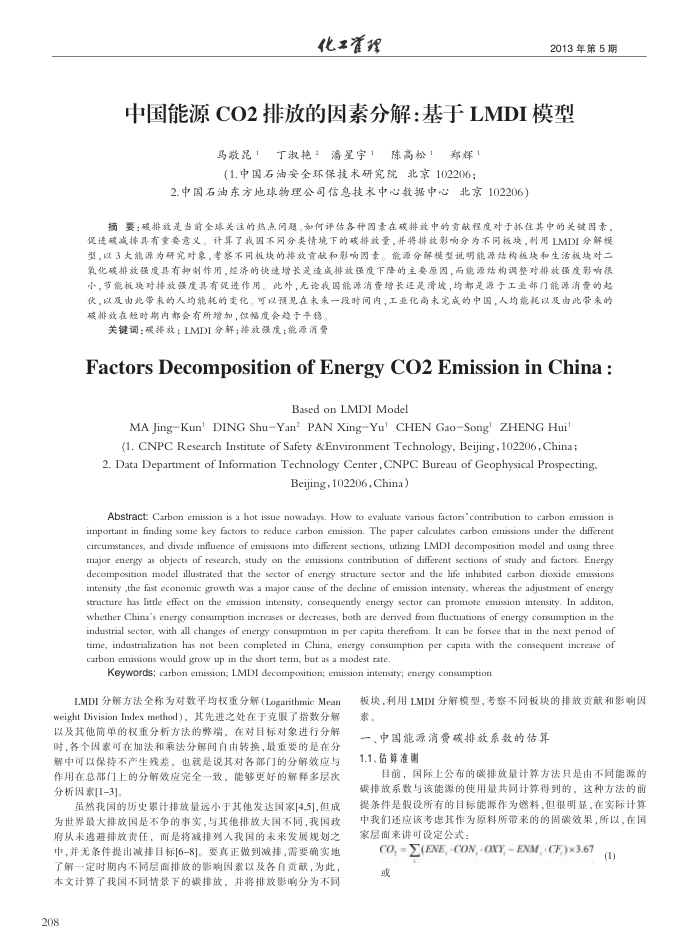中国能源CO2排放的因素分解:基于LMDI模型
内容简介
 化工理
化工理2013年第5期
中国能源CO2排放的因素分解:基于LMDI模型
马敬昆1丁淑艳2滑星宇1陈高松1郑辉1(1.中国石油安全环保技术研究院北京102206;
2.中国石油东方地球物理公司信息技术中心数据中心北京102206)
摘要:碳排效是当前全球关注的热点问题。如何评估各种因素在碳排放中的贡缺程度对于抓住其中的关建因素,促选碳减捧具有重要意义。计算了我国不同分类情境下的碳排款量,并将排放影响分为不同板块,利用LMDI分解模型,以3大能源为研究对象,考察不同板块的排放贡献和影响因素。能源分解模型试明能源结构版块和生活版块对二策化碳排放强度具有抑制作用,经济的快速增长是造成排放强度下降的主要原因,而能源结构调整对排放强度影响很小,节能板块对排放强度具有促进作用。此外,无论我国能源消费增长还是滑坡,均部是源于工业部门能源消费的起伏,以及由此带来的人均能耗的变化。可以预见在来来一段时间内,工业化高未完成的中国,人均能耗以及由此带来的碳排放在短时期内都会有所增加,但幅度会趋于平稳。
关键词:碳排放;LMDI分解;排放强度;能源消费
Factors Decomposition of Energy CO2Emission in China :
Based on LMDI Model
MA JingKun' DING ShuYan* PAN XingYu' CHEN Gao-Song' ZHENG Hui(1. CNPC Research Institute of Safety &Environment Technology, Beijing, 102206, China ;
2. Data Department of Information Technology Center, CNPC Bureau of Geophysical Prospecting
Beijing,102206,China)
Abstract: Carbon emission is a hot issue nowadays. How to evaluate various factors'contribution to carbon emission i important in finding some key factors to reduce carbon emission. The paper calculates carbon emissions under the different circumstances, and divide influence of emissions into different sections, utlizing LMDI decomposition model and using three major energy as objects of research, study on the emissions contribution of different sections of study and factors. Energy decomposition model illustrated that the sector of energy structure sector and the life inhibited carbon dioxide emissions intensity ,the fast economic growth was a major cause of the decline of emision intensity, whereas the adjustment of energy structure has litle effect on the emission intensity, consequently energy sector can promote emission intensity. In additon, whether China's energy consumption increases or decreases, both are derived from fluctuations of energy consumption in the industrial sector, with all changes of energy consupmtion in per capita therefrom. It can be forsee that in the next period of time, industrialization has not been completed in China, energy consumption per capita with the consequent increase of carbon emissions would grow up in the short tem, but as a modest rate.
Keywords: carbon emission; LMDI decomposition; emission intensity; energy consumption
LMDI分解方法全称为对数平均权重分解(LogarithmicMean weight DivisionIndexmethod),其先进之处在于克服了指数分解以及其他简单的权重分析方法的弊端,在对目标对象进行分解时,各个因素可在加法和乘法分解间自由转接,最重要的是在分解中可以保持不产生残差,也就是说其对各部门的分解效应与作用在总部门上的分解效应完全一致,能够更好的解释多层次分析因素[1-3]
虽然我国的历史累计排效量远小于其他发达国家[4,5],但成为世界最大排效国是不争的事实,与其他排效大国不同,我国政府从未逃避排效责任,而是将减排列人我国的未来发展规划之中,并无条件提出减排目标[6-8]。要真正做到减排,需要确实地了解一定时期内不同层面排放的影响因素以及各自贡献,为此,本文计算了我国不同情景下的碳排放,并将排效影响分为不同
208
板块,利用LMDI分解模型,考察不同板块的排放贡献和影响因素。
一、中国能源消费碳排放系数的估算 1.1、估算准则
目前,国际上公布的碳排效量计算方法只是由不同能源的碳排放系数与该能源的使用量共同计算得到的,这种方法的前提条件是假设所有的目标能源作为燃料,但很明显,在实际计算中我们还应该考虑其作为原料所带来的的固碳效果,所以,在国家层面来讲可设定公式:
CO, = Z(ENE, -CON, -QXY, ENM,·CF,)×3.67
(1)
或
上一章:一次盐水精制钡法脱硝工艺分析及存在的问题
下一章:一步法低温沉积SnO2